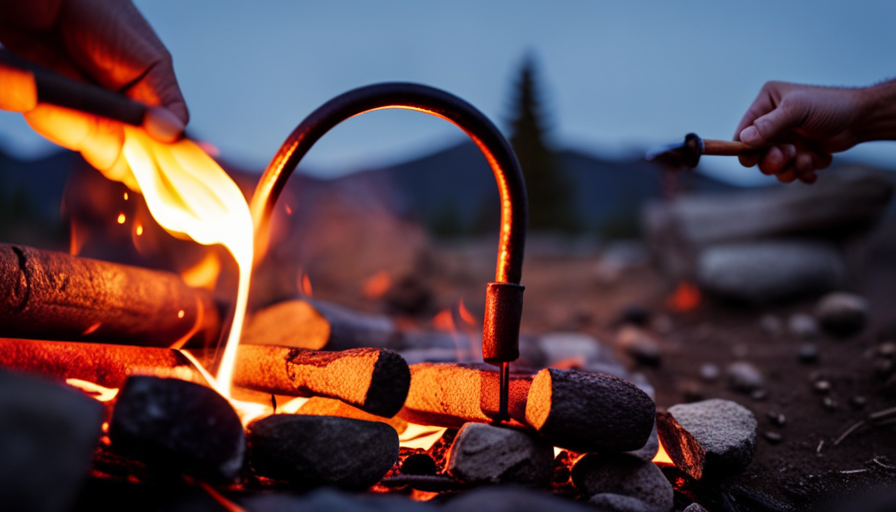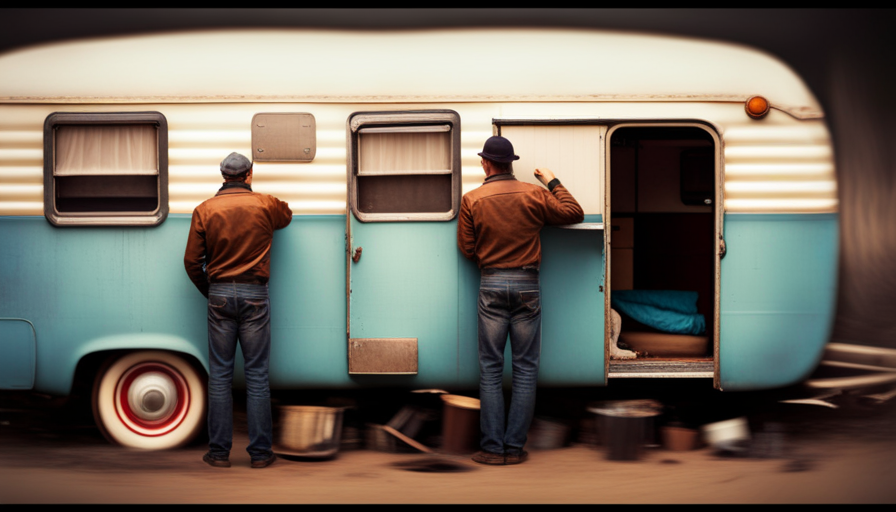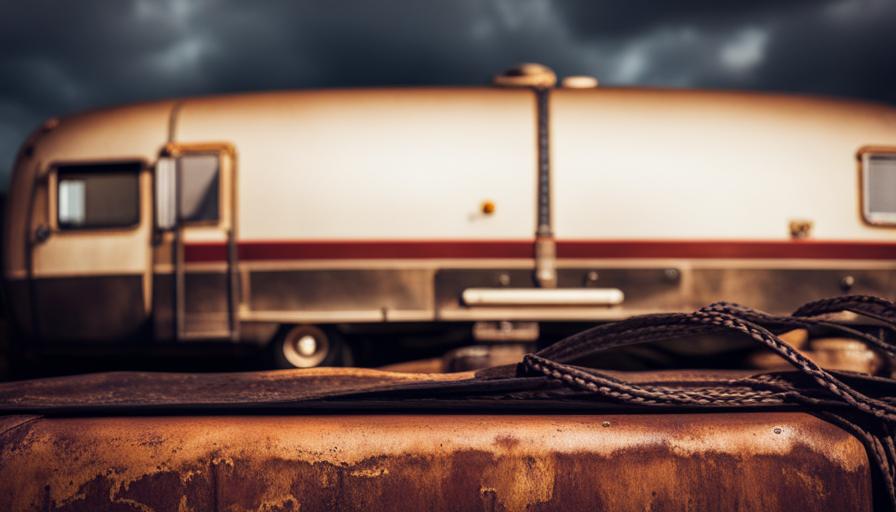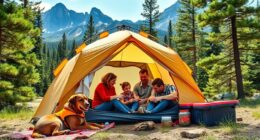With the drop in temperatures and chilly evenings approaching, now is the ideal time to start up your camper’s furnace to ensure cozy nights while on the road. Acting as a heat source in the wilderness, your camper’s furnace is ready to provide comfort and warmth in the midst of nature. But how do you properly ignite it? Fear not, fellow adventurers, as I am here to guide you through each step of the process.
In this detailed and informative article, I will share with you the technical know-how and essential tips to light your camper furnace like a pro. From familiarizing yourself with the furnace system to troubleshooting common issues, I’ve got you covered.
So gather your tools, ensure proper ventilation, and let’s get started on this journey to a warm and cozy camper experience.
Key Takeaways
- Familiarize yourself with the furnace system and locate the components.
- Turn off the propane supply before lighting the furnace for safety.
- Follow manufacturer’s instructions for lighting the pilot light or ignition system.
- Regularly clean and maintain the furnace to prevent potential issues.
Familiarize Yourself with the Furnace System
Before you can light the camper furnace, you need to familiarize yourself with the furnace system. Proper furnace maintenance and troubleshooting are essential to ensure its efficient operation.
To begin, locate the furnace in your camper. It’s typically installed in a dedicated compartment or under a seat. Once you’ve found it, open the access panel to reveal the furnace components.
Inside the furnace, you’ll find the burner assembly, blower motor, control board, and gas valve. Take note of their locations and how they’re connected. Understanding the layout will help you identify any potential issues during troubleshooting.
Next, familiarize yourself with the furnace controls. Most furnaces have a thermostat that allows you to adjust the temperature. It’s crucial to know how to operate the thermostat correctly to ensure the desired level of warmth inside your camper.
Additionally, familiarize yourself with the furnace maintenance procedures. This includes cleaning or replacing the air filters, inspecting the burner assembly for any debris, and checking the exhaust vent for any obstructions. Regular maintenance will prolong the life of your furnace and prevent any potential problems.
Now that you’re familiar with the furnace system, you can move on to gathering the necessary tools and supplies for lighting the furnace.
Gather the Necessary Tools and Supplies
First, make sure you’ve got all the tools and supplies you need to get that cozy warmth flowing in your home away from home. To light a camper furnace, you’ll need a few essential tools. Firstly, you’ll require a long-nose butane lighter or a fireplace match. These tools will allow you to easily reach the pilot light inside the furnace.
Additionally, it’s crucial to have a flashlight handy to help you see inside the furnace and ensure everything is functioning correctly.
When it comes to safety precautions, there are a few things you should keep in mind. Always make sure to turn off the propane supply before attempting to light the furnace. This will prevent any potential gas leaks and ensure your safety. It’s also crucial to check for any obstructions or debris in the furnace’s air intake and exhaust vents. Blockages can lead to poor ventilation and even carbon monoxide buildup, which can be extremely dangerous.
With the necessary tools and safety precautions in place, you can now move on to the next step: ensuring proper ventilation and safety precautions. This will help to maintain a safe and comfortable environment inside your camper.
Ensure Proper Ventilation and Safety Precautions
To keep your cozy camper safe and sound, it’s pivotal to prioritize proper ventilation and precautionary measures. Ventilation is of utmost importance when lighting a camper furnace as it ensures the proper flow of air and prevents the accumulation of harmful gases. Before starting the furnace, it is crucial to inspect the ventilation system and ensure that there are no blockages or obstructions. This can be done by checking the vents and exhaust pipes for any debris or signs of damage. Additionally, it is essential to make sure that the camper is adequately ventilated by opening windows or vents to allow fresh air to circulate.
To further enhance safety, there are certain measures that should be taken. Firstly, it is necessary to have a carbon monoxide detector installed in the camper. This device will alert you if there is a dangerous build-up of carbon monoxide, a colorless and odorless gas that can be fatal. Secondly, it is important to follow the manufacturer’s instructions for the furnace and use it according to its intended purpose. Avoid using makeshift methods or modifying the furnace, as this can lead to safety hazards.
Proper ventilation and safety measures are vital when lighting a camper furnace. By ensuring adequate airflow and taking necessary precautions, you can enjoy a warm and cozy camper without compromising your well-being. Now, let’s move on to the next section and learn how to locate and access the furnace ignition panel.
Locate and Access the Furnace Ignition Panel
Now, let’s find out where the ignition panel for your cozy camper’s furnace is located so you can easily access it. The ignition panel is typically located on the exterior of the furnace unit, usually towards the bottom. To access it, you’ll need to remove the furnace cover. This can usually be done by unscrewing a few screws or using a latch mechanism.
Once the cover is removed, you’ll be able to see the ignition panel. It’ll have a series of buttons or switches that control various functions of the furnace. Look for the ignition switch or button, which is responsible for starting the furnace. It’s important to note that the location of the ignition panel may vary depending on the make and model of your camper’s furnace, so refer to the owner’s manual for specific instructions.
When troubleshooting your furnace, accessing the ignition panel is essential. It allows you to check for any error codes or indicators that may help diagnose the issue. Additionally, you can perform basic maintenance tasks such as cleaning or replacing the ignition components if necessary.
With the ignition panel accessed, you can now move on to the next step: turning off the gas supply. This is crucial for your safety and to prevent any potential accidents or leaks.
Turn Off the Gas Supply
Before you continue any further, it’s important that you turn off the gas supply to ensure your safety and prevent any potential accidents or leaks. Gas safety is of utmost importance when dealing with a camper furnace. To emphasize the significance of this step, consider the following:
- Gas leaks can lead to fire hazards and explosions, which can cause severe injury or even death.
- Properly shutting off the gas supply reduces the risk of carbon monoxide poisoning, a silent killer that can be released by malfunctioning furnaces.
- Taking the time to turn off the gas ensures that the furnace isn’t accidentally ignited during maintenance, protecting you from burns or other injuries.
- By practicing good furnace maintenance, you not only safeguard your well-being but also extend the lifespan of your camper furnace, saving you money in the long run.
Now that you understand the importance of gas safety and furnace maintenance, it’s time to proceed to the next step: lighting the pilot light or ignition system.
Light the Pilot Light or Ignition System
Once the gas supply is safely turned off, it’s time to ignite the pilot light or ignition system and bring warmth back to your cozy camper. Lighting the pilot light or ignition system in your camper furnace can be done using different methods. Here are some common lighting methods and troubleshooting techniques to ensure a successful ignition.
| Lighting Method | Troubleshooting Technique |
|---|---|
| Manual Ignition | Check for proper gas flow and ensure the pilot tube is clear of any debris. |
| Electronic Ignition | Verify that the electronic ignition system is receiving power and check for any loose connections. |
| Piezo Ignition | Press the piezo ignition button firmly and listen for the clicking sound. If there is no spark, check the battery or replace the igniter. |
When attempting to light the pilot light or ignition system, it’s important to follow the manufacturer’s instructions specific to your furnace model. Remember to wait for any residual gas to dissipate before attempting to relight the furnace. Once the pilot light or ignition system is successfully lit, monitor the furnace for proper ignition and operation.
Monitor the Furnace for Proper Ignition and Operation
As I sit by the fire, savoring the warmth that fills the air, I can’t help but marvel at the mesmerizing dance of the flickering flames. I know that my cozy oasis is a result of the furnace’s successful ignition and operation.
When it comes to monitoring the furnace for proper ignition and operation, there are a few key tips to keep in mind.
First and foremost, if you encounter any issues with the ignition, it’s important to troubleshoot the problem. Check the gas supply to ensure it’s turned on and that the pilot light or ignition system is functioning correctly. If there are any blockages or obstructions in the gas line, they should be cleared immediately.
Once the furnace is successfully ignited, it’s crucial to monitor its operation. Keep an eye on the flame. It should be a steady, blue flame. If you notice any changes in color or shape, it could indicate a problem that needs to be addressed.
Additionally, make sure the furnace is operating smoothly and efficiently. Check for any unusual noises or smells that could signify a malfunction. Regularly clean and maintain the furnace to prevent any potential issues.
With these ignition troubleshooting and furnace operation tips in mind, you can ensure that your cozy oasis remains warm and inviting.
Now, let’s transition to the next section about how to adjust the temperature and fan settings.
Adjust the Temperature and Fan Settings
Get ready to experience ultimate comfort by effortlessly adjusting the temperature and fan settings in your cozy sanctuary. To ensure optimal performance, follow these steps for adjusting thermostat settings:
Start by locating the thermostat control panel. It’s usually mounted on the wall near the furnace.
Use the arrow keys or dial to adjust the desired temperature. You can increase or decrease the temperature according to your preference.
If you encounter any issues with the fan, troubleshoot by checking the fan settings. Make sure the fan is set to the appropriate mode, such as auto or on, and adjust it as needed.
If the fan isn’t functioning properly, check the power supply and make sure it’s connected securely.
Additionally, make sure the fan blades are clean and free from debris, as this can affect its performance.
By regularly maintaining and cleaning your furnace, you can ensure it operates smoothly and efficiently. This includes tasks like replacing air filters, inspecting and cleaning the blower motor, and checking for any blockages in the air vents.
Taking these steps will help maximize the lifespan of your furnace and keep it running at its best.
Regularly Maintain and Clean Your Furnace
Ensure your cozy sanctuary remains a haven of warmth and comfort by regularly maintaining and cleaning your furnace, prolonging its lifespan and optimizing its performance. Cleaning techniques are an essential part of furnace maintenance, as they help remove dirt, dust, and debris that can impede airflow and reduce efficiency.
Start by turning off the furnace and disconnecting the power. Remove the furnace cover and use a soft brush or vacuum to gently clean the interior components, including the burners, blower, and heat exchanger. Be careful not to damage any delicate parts.
Next, check and clean the air filters, either by vacuuming or replacing them if necessary. It’s recommended to clean or replace the filters every one to three months, depending on usage.
Additionally, make sure to inspect and clean the vents and ductwork to prevent any blockages that could hinder airflow.
To maintain your furnace’s optimal performance, create a maintenance schedule that includes regular cleaning, filter replacement, and professional inspections. By following these cleaning techniques and maintenance practices, you can ensure your furnace operates at its best.
Transitioning into the next section about troubleshooting tips and common issues, it’s important to know how to address any potential problems that may arise with your furnace.
Troubleshooting Tips and Common Issues
Now that we’ve covered the importance of regularly maintaining and cleaning your camper furnace, let’s move on to troubleshooting tips and common issues that you may encounter.
When it comes to troubleshooting, it’s essential to start with the basics. First, check if your furnace is getting power by ensuring that the circuit breaker is on and the thermostat is set correctly. If there’s power but the furnace isn’t working, it might be due to a clogged air filter. Clean or replace the filter if necessary, as a dirty filter can restrict airflow and cause the furnace to malfunction.
Another common problem is a faulty igniter. If your furnace isn’t producing heat, it could be because the igniter is worn out or dirty. Cleaning or replacing the igniter should resolve this issue.
Additionally, check for any obstructions in the exhaust vent or intake pipe, as blockages can cause the furnace to shut off.
If you’ve tried these troubleshooting steps and still can’t get your furnace to work properly, it’s best to consult a professional technician. They have the expertise to diagnose and fix more complex issues.
Remember, proper maintenance and regular inspections can help prevent these common problems and ensure your camper furnace functions efficiently.
Frequently Asked Questions
How do I know if my camper furnace needs to be cleaned or maintained?
If you’re experiencing issues with your camper furnace, it’s important to troubleshoot and determine if it needs cleaning or maintenance.
Did you know that 80% of furnace breakdowns are caused by lack of maintenance?
Signs of a dirty furnace include reduced heating efficiency, strange smells, and uneven heating.
To clean it, turn off the power, remove and clean the furnace components, and check for any blockages.
Regular maintenance will ensure your furnace runs smoothly and efficiently.
What are some common issues that can occur with a camper furnace?
Common furnace problems can be a hassle, but troubleshooting tips can help. Some issues include a malfunctioning thermostat, a dirty or clogged furnace filter, a faulty ignition system, or a blocked exhaust vent.
To fix these problems, check and replace the thermostat batteries, clean or replace the filter, inspect and repair the ignition system, and clear any obstructions in the exhaust vent.
Regular maintenance and cleaning can prevent many of these common issues from occurring.
How often should I check and replace the furnace filter?
I check and replace the furnace filter in my camper on a regular basis to ensure optimal performance. The check frequency for the furnace filter depends on several factors such as usage, environmental conditions, and the type of filter being used. It’s recommended to inspect the filter at least once a month and replace it as needed.
Regular filter replacement helps maintain good air quality, improves furnace efficiency, and prevents potential issues caused by a dirty or clogged filter.
Can I use any type of fuel to light the pilot light?
Different types of igniters for camper furnaces exist, but it’s important to use the correct one for safety and efficiency. Alternative methods to light the pilot light may not be recommended, as they can pose a risk of malfunction or damage to the furnace. It’s best to consult the manufacturer’s guidelines for the specific type of fuel and igniter recommended for your camper furnace. Safety should always be the top priority when dealing with any heating equipment.
What should I do if the furnace does not ignite after following the steps?
If the furnace doesn’t ignite after following the steps, there might be a few troubleshooting options to consider. First, check if the fuel supply is sufficient and properly connected. Ensure that the thermostat is set to the desired temperature and functioning correctly. If the issue persists, it might be helpful to consult a professional technician to further diagnose the problem.
In the meantime, consider alternative ways to heat your camper, such as using electric space heaters or portable propane heaters.
Conclusion
Well, congratulations! You’ve successfully learned how to light a camper furnace. Now you can bask in the glory of being the ultimate furnace ignition master.
With your newfound knowledge, you can impress your friends with your ability to navigate the complex world of camper furnace systems. So go forth, my friend, and let the warm and cozy embrace of your perfectly lit furnace be a testament to your superior camping skills.
And remember, always stay safe and keep those vents clear! Happy camping!










